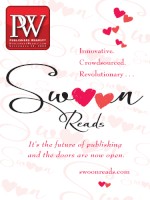Roughly the same portion of adult Americans read at least one book in 2012 as did in 2008, but the share of adults who read at least one work of literature last year fell. That’s one finding from a new National Endowment for the Arts report, “How a Nation Engages with Art,” based on the agency’s “2012 Survey of Public Participation in the Arts.”
According to the report, 46.9% of adults read at least one work of literature (a work of literature being defined here as a play, a novel, or a collection of short stories or poetry) in 2012, down from 50.2% in 2008, and even with the 2002 figure. Looking at the share of American adults who read at least one book of any kind, however, the share rose slightly to 54.5% last year, compared to 54.3% in 2008. The report also found that 58% of adults who read more than one book read both fiction and nonfiction, compared to 23% who read fiction only and 19% who read nonfiction exclusively.
When the study was conducted in 2002, the NEA found that the share of American adults who read at least one work of literature fell significantly from 1992, when it reached 54%—a finding that prompted then-NEA chairman Dana Gioia to create a number of initiatives to promote fiction and poetry reading among adults. The gains achieved by those programs—including the Big Read—between 2002 and 2008 were erased from 2008–2012. The share of adults who read poetry fell the most sharply in the period, dropping from 8.3% in 2008 to 6.7% last year; participation levels in reading novels and short plays fell to 45.1% in 2012, compared to 47% in 2008. The share of adults who read at least one play actually rose to 2.9% last year, from 2.6% in 2008.
The percentage of male adults who read at least one work of literature in the year fell to 36.9% from 41.9%, whereas the share of women was 56.1%, down slightly from 58% in 2008. The percentage of women who read one or more books (fiction or nonfiction) rose from 61.7% in 2008 to 63.6% last year, while the share of men who read at least one book fell moderately, to 44.7%, from 46.3% in 2008. Reading rates rose among Hispanic and African-American groups, but the percentage of white Americans who read at least one book in 2012 slipped to 60.6%, from 60.8% in 2008. There was a notable decline in the share of adults with only some high school education who read at least one book in 2012, whereas reading rates held relatively steady among other respondent groups categorized by education level.
NEA research director Sunil Iyengar said that while it was encouraging that overall reading held even, there is no doubt a slump in literary reading took place between 2008 and 2012. He was particularly concerned about the deep decline in poetry reading, although he said the survey didn’t address the causes for the decline. He said the rise of electronic media had a bit of a mixed impact on reading: reading, (after music), was the second highest activity people reported using electronic media for, although he acknowledged it was a fair question to ask if more digital entertainment options have played a role in dropping literary reading rates. Iyengar said he hoped the report would cause the literary community to look more closely at why reading literature declined again after the rise in 2008 and look for ways to reverse or stabilize the trend.
Percentage of American Adults Who Read at Least One Book in 2008 vs. 2012
| 2008 | 2012 | |
| All Adults | 54.3% | 54.5% |
|---|---|---|
| Gender | ||
| Male | 46.3% | 44.7% |
| Female | 61.7% | 63.6% |
| Race and Ethnicity | ||
| Hispanic | 32.8% | 36.3% |
| White | 60.8% | 60.6% |
| African-American | 43.4% | 46.2% |
| Other | 47.7% | 49.9% |
| Age | ||
| 18–24 | 50.7% | 51.8% |
| 25–34 | 54.1% | 54.8% |
| 35–44 | 56.2% | 53.0% |
| 45–54 | 54.2% | 53.2% |
| 55–64 | 58.4% | 56.5% |
| 65–74 | 54.5% | 61.1% |
| 75–up | 47.4% | 52.4% |
| Education Level | ||
| Grade School | 18.7% | 21.5% |
| Some High School | 33.4% | 27.7% |
| High School Graduate | 41.5% | 41.2% |
| Some College | 60.0% | 59.8% |
| College Graduate | 74.1% | 72.5% |
| Graduate School | 80.8% | 81.7% |



 Volume 260
Issue 39
09/30/2013
Volume 260
Issue 39
09/30/2013





